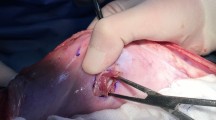Abstract
Purpose
The primary objective of this observational study was to determine the best possible dilution of fibrin glue (Tissucol) to employ for prosthesis fixing in laparoscopic treatment of abdominal wall defects and, secondly, to assess its feasibility and safety.
Materials and methods
This study was carried out in a university experimental animal laboratory in accordance with all international laws, ethics regulations and quality criteria associated with animal experiments. The tests were carried out on two pigs, using four samples of mesh (Parietex). All meshes were fixed using two different Tissucol dilutions (standard with distilled water and that with calcium chloride). Follow-up evaluations were at 15 days after 30 days, with the latter consisting of traction tests and a biopsy for histological analysis.
Results
No post-operative complications were observed. The collagen-coated polyester meshes showed 0% adhesions, and reperitonealization had ensued after 15 days. We saw no shrinkage or migration of any of the meshes. Histopathological analyses confirmed a greater stability, greater tissue integration and the largest number of fibroblasts in meshes fixed with a 1/10 Tissucol dilution without calcium chloride.
Conclusions
This observational study using animals showed that the 1/10 standard dilution – not that with calcium chloride – provided the best fixation and integration and prevented the formation of intraperitoneal adhesions, provided a hydrophilic collagen film-covered mesh was used.







Similar content being viewed by others
References
Canonico S, Sciaudone G, Pacifico F, Santoriello A (1999) Inguinal hernia repair in patients with coagulation problems: prevention of postoperative bleeding with human fibrin glue. Surgery 125:315–317
Carbajo MA, Martin del Olmo JC, Blanco JI, de la Cuesta C, Toledano M, Martin F, Vaquero C, Inglada L (1999) Laparoscopic treatment vs open surgery in the solution of major incisional and abdominal wall hernias with mesh. Surg Endosc 13:250–252
Hidalgo M, Castillo MJ, Eymar JL, Hidalgo A (2005) Lichtenstein inguinal hernioplasty: sutures versus glue. Hernia. doi:10.1007/s10029-005-0334x. Cited 13 May 2005
Katkhouda N, Mavor E, Friedlander MH, Mason RJ, Kiyabu M, Grant SW, Achanta K, Kirkman EL, Narayanan K, Essani R (2001) Use of fibrin sealant for prosthetic mesh fixation in laparoscopic extraperitoneal inguinal hernia repair. Ann Surg 233:18–25
Novik B, Hagedorn S, Mork U-B, Dahlin K, Skullman S, Dalenback J (2006) Fibrin glue for securing the mesh in laparoscopic totally extraperitoneal inguinal hernia repair. A study with a 40-month prospective follow-up period. Surg Endosc 20:462–467
Topart P, Vandenbroucke F, Lozac’h P (2005). Tisseel versus tack staples as mesh fixation in totally extraperitoneal laparoscopic repair of groin hernias. A retrospective analysis. Surg Endosc 19:724–727
Redl H (2004) History of tissue adhesives. In: Saltz R, Toriumi DM (eds) Tissue glues in cosmetic surgery. Quality Medical, St Louis, Mo., pp 3–27
Jackson MR (2001) Fibrin sealants in surgical practice: an overview. Am J Surg 182:1S–7S
Grossman JA, Capraro PA, Burneikis V (2001) Minimizing complications in the use of fibrin sealant in aesthetic facial procedure. Aesthet Surg J 21:32–39
Bagot D’Arc M, Daculsi G (2003) Micro macroporous biphasic ceramics and fibrin sealant as a moldable material for bone reconstruction in chronic otitis media surgery: a 15 year experience. J Mater Sci Mater Med 14:229–233
Amrani DL, Di Orio JP, Delmotte Y (2001) Wound healing: role of commercial fibrin sealants. Ann N Y Acad Sci 936:566–579
Sasaki GH, Mirzai T, Potyondy L, Smith M (2003) In vivo use of human fibrin glue under the subperiosteal and subcutaneous planes in Holtzman rats. Aesthet Surg J 23:1–6
Corrente G, Abundo R, Cardaropoli D et al (2000) Long term evaluation of osseointegrated implants in regenerated and nonregenerated bone. Int J Periodont Rest 20:391
Goessl A, Redl H (2004) Optimized thrombin dilution protocol for a slowly setting fibrin sealant in surgery. Eur Surg 37/1:1–9
Dinges HP, Redl H, Thurnher M, Schiesser A, Schlag G (1986) Morphometric studies on wound healing after systemic administration of adriamycin and local application of fibrin sealant. Pathol Res Pract 181:745–754
Fèrnandez Lobato R, Garcia Septiem J, Ortega Deballon P, Martin Lucas FJ, Ruiz deAdana JC, Limones Esteban M (2001) Tissucol application in dermolipectomy and incisional hernia repair. Int Surg 86:240–245
Author information
Authors and Affiliations
Corresponding author
Rights and permissions
About this article
Cite this article
Olmi, S., Addis, A., Domeneghini, C. et al. Experimental comparison of type of Tissucol dilution and composite mesh (Parietex) for laparoscopic repair of groin and abdominal hernia: observational study conducted in a university laboratory. Hernia 11, 211–215 (2007). https://doi.org/10.1007/s10029-007-0199-2
Received:
Accepted:
Published:
Issue Date:
DOI: https://doi.org/10.1007/s10029-007-0199-2




